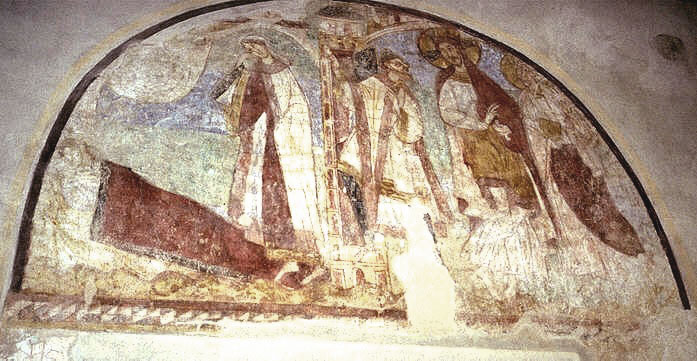Copford Green, Essex (†Chelmsford) c.1130
The Raising of Jairus’s Daughter

This is one of the few paintings in the church to escape very heavy restoration – amounting to complete and almost certainly inaccurate repainting – in 1872. Most of the other, repainted, subjects are in the apsidal chancel, but The Raising of Jairus’s daughter¹ is on the south wall of the nave, and although it has undoubtedly been restored, it does not seem to have been seriously distorted in the process; what we have is probably essentially what the 12th century artist left.
The painting is also stylistically very unlike those (of the same original date) in the chancel. Even allowing for distortion and inaccuracy in the restoration, the chancel paintings, centering around a Christ in Majesty or Maestà, are formal, hierarchical and look, in short, like Byzantine art. This one, though, is dynamic, fluid and above all, narrative. It may be the work of a different painter, or it may be that this less formal style and story-based subject was thought appropriate for the nave – the domain of the people as opposed to the priest.
The figures are grouped in an illusionistic lunette, or half-moon shape, and the scene is divided into two by a central ‘pillar’, painted as an architectural detail. The idea was obviously to suggest an inner room on the left, and the vestibule and entrance to Jairus’s house on the right. Jairus’s daughter lies in bed, a weeping woman, probably her mother, standing beside her. In the doorway between the two rooms, Jairus, painted as stereotypically Jewish with a sharply pointed beard and a cap, stands, pointing to the inner chamber and obviously beseeching Christ to help the young woman. Christ himself, who has a tripartite halo, stands at the right. His pose is unusual in that his legs are crossed, with underdrawing of the limbs visible where an area of lower drapery has faded. Since this painting, unlike the others in the church, is a true fresco, completed in a single phase on wet plaster, what we see here may be the painter working out his ideas about the articulation of the figures as he applies the paint, and perhaps changing his mind in the process. There is another figure, probably Peter, who was present according to both Luke 8:41-51 and Mark 5:37 at the far right. The painter has chosen the moment before the miracle happened.
Dubious as most of Copford’s painting is from the point of view of authenticity, such a lavish painted scheme is not immediately easy to account for in an ordinary parish church of the 12th century. But the very useful illustrated booklet in the church (see note below) points out that the Manor of Copford was held by the Bishops of London in Saxon times, and according to Domesday Book (1086) this was still the case after the Norman Conquest There is no documentary evidence beyond this, but it is generally believed that the first Norman bishops would have lived in the Manor, probably at a site now occupied by Copford Hall, a Georgian building. On this hypothesis, the church would have been their chapel.
The Copford Raising of Jairus’s daughter is an extremely rare example of a painting of an incident in Christ’s earthly ministry. One other, at Brook in Kent, is now on the site. There may once have been many more, but in that case it seems odd that so few have survived.
Website for St Michael & All Angels, Copford
¹ A report of the first uncovering of this painting in 1690 (it was promptly whitewashed over again), written 20 years after the event and quoted in the illustrated booklet [text by AJ Wright, 1993] in the church, identifies this painting as “St Peter’s mother-in-law, lying sick of a fever”, as in Matthew 8:14-16, but the modern interpretation seems more likely.